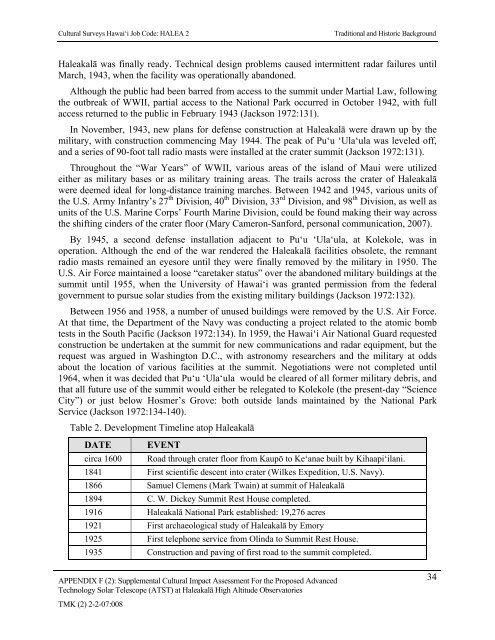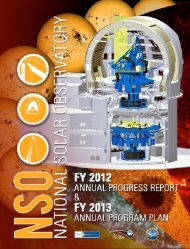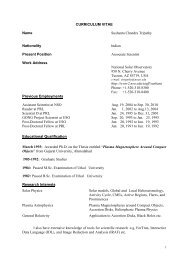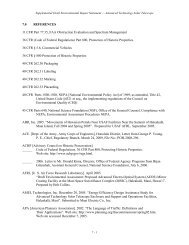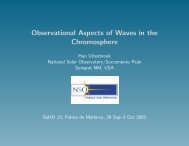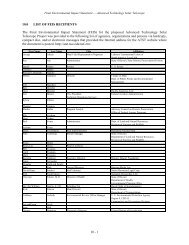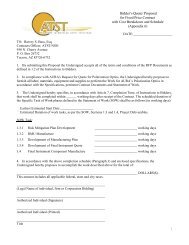F2 - ATST
F2 - ATST
F2 - ATST
You also want an ePaper? Increase the reach of your titles
YUMPU automatically turns print PDFs into web optimized ePapers that Google loves.
Cultural Surveys Hawai‘i Job Code: HALEA 2Traditional and Historic BackgroundHaleakalā was finally ready. Technical design problems caused intermittent radar failures untilMarch, 1943, when the facility was operationally abandoned.Although the public had been barred from access to the summit under Martial Law, followingthe outbreak of WWII, partial access to the National Park occurred in October 1942, with fullaccess returned to the public in February 1943 (Jackson 1972:131).In November, 1943, new plans for defense construction at Haleakalā were drawn up by themilitary, with construction commencing May 1944. The peak of Pu‘u ‘Ula‘ula was leveled off,and a series of 90-foot tall radio masts were installed at the crater summit (Jackson 1972:131).Throughout the “War Years” of WWII, various areas of the island of Maui were utilizedeither as military bases or as military training areas. The trails across the crater of Haleakalāwere deemed ideal for long-distance training marches. Between 1942 and 1945, various units ofthe U.S. Army Infantry’s 27 th Division, 40 th Division, 33 rd Division, and 98 th Division, as well asunits of the U.S. Marine Corps’ Fourth Marine Division, could be found making their way acrossthe shifting cinders of the crater floor (Mary Cameron-Sanford, personal communication, 2007).By 1945, a second defense installation adjacent to Pu‘u ‘Ula‘ula, at Kolekole, was inoperation. Although the end of the war rendered the Haleakalā facilities obsolete, the remnantradio masts remained an eyesore until they were finally removed by the military in 1950. TheU.S. Air Force maintained a loose “caretaker status” over the abandoned military buildings at thesummit until 1955, when the University of Hawai‘i was granted permission from the federalgovernment to pursue solar studies from the existing military buildings (Jackson 1972:132).Between 1956 and 1958, a number of unused buildings were removed by the U.S. Air Force.At that time, the Department of the Navy was conducting a project related to the atomic bombtests in the South Pacific (Jackson 1972:134). In 1959, the Hawai‘i Air National Guard requestedconstruction be undertaken at the summit for new communications and radar equipment, but therequest was argued in Washington D.C., with astronomy researchers and the military at oddsabout the location of various facilities at the summit. Negotiations were not completed until1964, when it was decided that Pu‘u ‘Ula‘ula would be cleared of all former military debris, andthat all future use of the summit would either be relegated to Kolekole (the present-day “ScienceCity”) or just below Hosmer’s Grove: both outside lands maintained by the National ParkService (Jackson 1972:134-140).Table 2. Development Timeline atop HaleakalāDATEcirca 1600EVENTRoad through crater floor from Kaupō to Ke‘anae built by Kihaapi‘ilani.1841 First scientific descent into crater (Wilkes Expedition, U.S. Navy).1866 Samuel Clemens (Mark Twain) at summit of Haleakalā1894 C. W. Dickey Summit Rest House completed.1916 Haleakalā National Park established: 19,276 acres1921 First archaeological study of Haleakalā by Emory1925 First telephone service from Olinda to Summit Rest House.1935 Construction and paving of first road to the summit completed.APPENDIX F (2): Supplemental Cultural Impact Assessment For the Proposed Advanced 34Technology Solar Telescope (<strong>ATST</strong>) at Haleakalā High Altitude ObservatoriesTMK (2) 2-2-07:008


